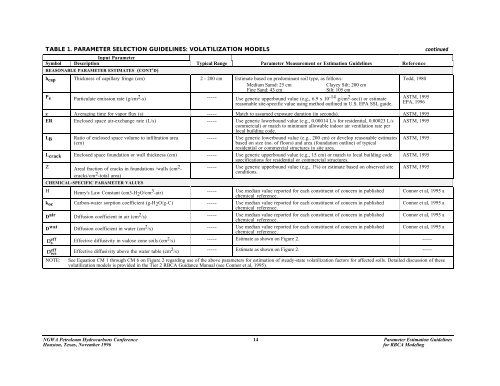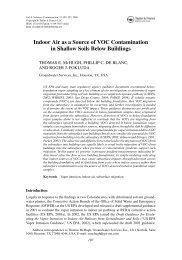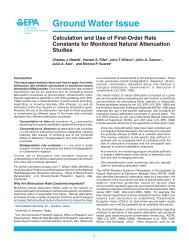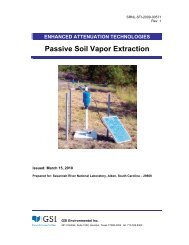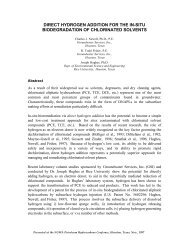Parameter Estimation Guidelines for Risk-Based Corrective Action ...
Parameter Estimation Guidelines for Risk-Based Corrective Action ...
Parameter Estimation Guidelines for Risk-Based Corrective Action ...
You also want an ePaper? Increase the reach of your titles
YUMPU automatically turns print PDFs into web optimized ePapers that Google loves.
TABLE 1. PARAMETER SELECTION GUIDELINES: VOLATILIZATION MODELS continued<br />
Input <strong>Parameter</strong><br />
Symbol Description Typical Range <strong>Parameter</strong> Measurement or <strong>Estimation</strong> <strong>Guidelines</strong> Reference<br />
REASONABLE PARAMETER ESTIMATES (CONT'D)<br />
h cap Thickness of capillary fringe (cm) 2 - 200 cm Estimate based on predominant soil type, as follows:<br />
Medium Samd: 25 cm<br />
Clayey Silt: 200 cm<br />
Fine Sand: 43 cm<br />
Silt: 105 cm<br />
P e Particulate emission rate (g/cm 2 -s) ----- Use generic upperbound value (e.g., 6.9 x 10 -14 g/cm 2 -sec)) or estimate<br />
reasonable site-specific value using method outlined in U.S. EPA SSL guide.<br />
Todd, 1980<br />
ASTM, 1995<br />
EPA, 1996<br />
z Averaging time <strong>for</strong> vapor flux (s) ----- Match to assumed exposure duration (in seconds). ASTM, 1995<br />
ER Enclosed space air-exchange rate (L/s) ----- Use generic lowerbound value (e.g., 0.00014 L/s <strong>for</strong> residential, 0.00023 L/s ASTM, 1995<br />
commercial) or match to minimum allowable indoor air ventilation rate per<br />
local building code.<br />
L B Ratio of enclosed space volume to infiltration area<br />
----- Use generic lowerbound value (e.g., 200 cm) or develop reasonable estimates ASTM, 1995<br />
(cm)<br />
based on size (no. of floors) and area (foundation outline) of typical<br />
residential or commercial structures in site area.<br />
L crack Enclosed space foundation or wall thickness (cm) ----- Use generic upperbound value (e.g., 15 cm) or match to local building code ASTM, 1995<br />
specifications <strong>for</strong> residential or commercial structures.<br />
Ζ Areal fraction of cracks in foundations /walls (cm 2 -<br />
----- Use generic upperbound value (e.g., 1%) or estimate based on observed site ASTM, 1995<br />
cracks/cm 2 conditions.<br />
-total area)<br />
CHEMICAL-SPECIFIC PARAMETER VALUES<br />
Η Henry's Law Constant (cm3-H 2 O/cm 3 -air) ----- Use median value reported <strong>for</strong> each constituent of concern in published<br />
chemical reference.<br />
Connor et al, 1995 a<br />
k oc Carbon-water sorption coefficient (g-H 2 O/g-C) ----- Use median value reported <strong>for</strong> each constituent of concern in published Connor et al, 1995 a<br />
chemical reference.<br />
D air Diffusion coefficient in air (cm 2 /s) ----- Use median value reported <strong>for</strong> each constituent of concern in published<br />
chemical reference.<br />
Connor et al, 1995 a<br />
D wat Diffusion coefficient in water (cm 2 /s) ----- Use median value reported <strong>for</strong> each constituent of concern in published<br />
chemical reference.<br />
Connor et al, 1995 a<br />
D<br />
eff s Effective diffusivity in vadose zone soils (cm 2 /s) ----- Estimate as shown on Figure 2. -----<br />
D<br />
eff ws Effective diffusivity above the water table (cm 2 /s) ----- Estimate as shown on Figure 2. -----<br />
NOTE: See Equation CM 1 through CM 6 on Figure 2 regarding use of the above parameters <strong>for</strong> estimation of steady-state volatilization factors <strong>for</strong> affected soils. Detailed discussion of these<br />
volatilization models is provided in the Tier 2 RBCA Guidance Manual (see Connor et al, 1995).<br />
NGWA Petroleum Hydrocarbons Conference 14 <strong>Parameter</strong> <strong>Estimation</strong> <strong>Guidelines</strong><br />
Houston, Texas, November 1996<br />
<strong>for</strong> RBCA Modeling


